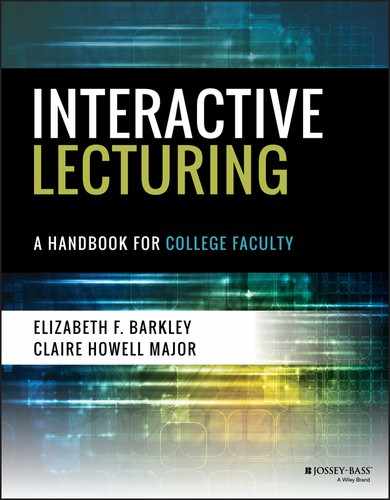CHAPTER 7
Designing Effective Audiovisuals
Lecturing today practically implies use of audiovisuals, particularly in the form of presentation software and slide decks. But are audiovisuals always necessary? Are they always a good idea? Try to recall some of the best speeches of all time. Which ones come to mind? Martin Luther King's “I Have a Dream” speech? Abraham Lincoln's “Gettysburg Address”? Susan B. Anthony's “Women's Rights to Suffrage”? Of the speakers and speeches that came to your mind, consider this question: who had the best PowerPoint? Of course most of the speakers didn't have access to presentation packages, computers, or projectors, so perhaps the question is unfair. But consider this one instead: how many of these speeches would have been improved by the use of audiovisual supports? Our guess is not any.
Why use audiovisuals during lectures at all? Many of our most important communication acts occur without the use of slides. There is something powerful about the human voice on its own. There is something useful about speaking directly to another person or a group of people. Indeed, speaking without slides has several advantages. If you don't use slides, you don't have to worry about technology failure. If you don't use slides, students pay more attention to you. Moreover, slides can lock you in to what you will say, when you will say it, and how you will say it. If you are an expert on your topic, you may want more flexibility than preset audiovisuals will allow.
There are, however, many times that it is better to use audiovisuals. They can help students pay attention. If you have complicated ideas, audiovisuals can host graphs and illustrations that can help students better understand. Sometimes it is simply more appropriate and effective to convey information visually rather than orally (Mayer, 2017). Having effective audiovisuals can make you seem more prepared as a speaker. Moreover, audiovisuals can help you as a speaker by reminding you of points you want to make and ensure that you stay on track. In this chapter, we offer several Tips that focus on creating and using presentation slides and other audiovisuals effectively. We summarize these Tips in Exhibit 7.1.
Key Reference and Resource
- Mayer, R. E. (2017). Principles for learning from multimedia with Richard Mayer. Retrieved from https://hilt.harvard.edu/blog/principles-multimedia-learning-richard-e-mayer
